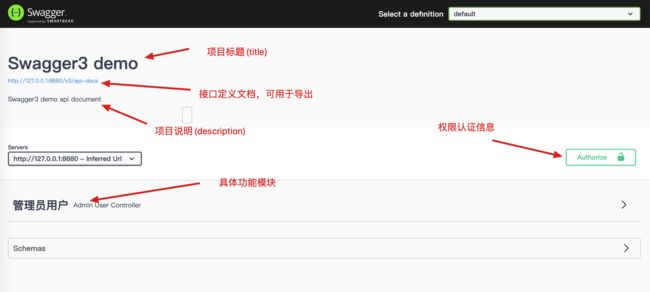Spring Boot 2.4 集成 OpenApi/Swagger 3.0
文章目录
-
-
- 1 摘要
- 2 核心 Maven 依赖
- 3 核心代码
-
- 3.1 application.yml 配置
- 3.2 Swagger 3 配置信息
- 3.3 Swagger 常用注解使用
-
- 3.3.1 请求与返回参数
- 3.3.2 Controller 层
- 4 Swagger 3.0 界面地址
- 5 Swagger UI 界面说明
- 6 推荐参考文档
- 7 Github 源码
-
1 摘要
Swagger 作为最受欢迎的后台接口文档生成框架,其知名度自然不用多言。目前市面上绝大多数的 Swagger 还停留在 2.0 时代,而 Swagger 2.0 在 2017 年官方已经停止维护。相对于 2.0 ,Swagger 3.0 依赖更加简洁,更易于集成。本文将介绍基于 Spring boot 2.4 集成 OpenApi Swagger 3.0。
Swagger 官方文档: https://swagger.io/
作者早前文档:
SpringBoot 2.X集成Swagger2生成 RESTFul 风格API接口文档
2 核心 Maven 依赖
./demo-swagger3/pom.xml
<dependency>
<groupId>io.springfoxgroupId>
<artifactId>springfox-boot-starterartifactId>
<version>${springfox-swagger3.version}version>
dependency>
这里 ${springfox-swagger3.version} 的版本号为 3.0.0
3 核心代码
3.1 application.yml 配置
./demo-swagger3/src/main/resources/application.yml
## Swagger3
swagger3:
enable: true
title: Swagger3 demo
description: Swagger3 demo api document
authHeaderKey: token
这些信息是自定义的,用于将 Swagger 的信息可配置化
swagger3.enable: 是否启用 Swagger
swagger3.title: 用于定义 Swagger UI 的标题
swagger3.description: 定义Swagger UI 的描述信息
swagger3.authHeaderKey: 定义 Swagger UI 上边的权限认证的头部信息的 key,如使用 token 作为权限认证方式,其 header 的 key 为 token,则 swagger3.authHeaderKey=token
3.2 Swagger 3 配置信息
./demo-swagger3/src/main/java/com/ljq/demo/springboot/swagger3/common/config/Swagger3Config.java
package com.ljq.demo.springboot.swagger3.common.config;
import io.swagger.annotations.Api;
import io.swagger.models.auth.In;
import org.springframework.beans.factory.annotation.Value;
import org.springframework.context.annotation.Bean;
import org.springframework.context.annotation.Configuration;
import springfox.documentation.builders.ApiInfoBuilder;
import springfox.documentation.builders.PathSelectors;
import springfox.documentation.builders.RequestHandlerSelectors;
import springfox.documentation.oas.annotations.EnableOpenApi;
import springfox.documentation.service.*;
import springfox.documentation.spi.DocumentationType;
import springfox.documentation.spi.service.contexts.SecurityContext;
import springfox.documentation.spring.web.plugins.Docket;
import java.util.Collections;
import java.util.List;
/**
* @Description: Swagger3 拦截器
* @Author: junqiang.lu
* @Date: 2021/1/25
*/
@EnableOpenApi
@Configuration
public class Swagger3Config {
@Value("${swagger3.enable}")
private Boolean enableSwagger;
@Value("${swagger3.title}")
private String title;
@Value("${swagger3.description}")
private String description;
@Value("${swagger3.authHeaderKey}")
private String authHeaderKey;
@Bean
public Docket docket() {
return new Docket(DocumentationType.OAS_30)
.pathMapping("/")
// 是否启用
.enable(enableSwagger)
// Swagger UI 头部信息
.apiInfo(apiInfo())
// 指定生成文档的接口
.select()
.apis(RequestHandlerSelectors.withClassAnnotation(Api.class))
.paths(PathSelectors.any())
.build()
// 设置安全认证信息
.securitySchemes(securitySchemes())
// 设置安全认证应用范围
.securityContexts(securityContexts());
}
/**
* Swagger UI 头部信息
*
* @return
*/
private ApiInfo apiInfo() {
return new ApiInfoBuilder()
.title(title)
.description(description)
.build();
}
/**
* 权限认证信息(token)
*
* @return
*/
private List<SecurityScheme> securitySchemes() {
ApiKey apiKey = new ApiKey(authHeaderKey, authHeaderKey, In.HEADER.toValue());
return Collections.singletonList(apiKey);
}
/**
* 设置权限认证应用范围
*/
private List<SecurityContext> securityContexts() {
return Collections.singletonList(
SecurityContext.builder()
.securityReferences(Collections.singletonList(new SecurityReference(authHeaderKey,
new AuthorizationScope[]{new AuthorizationScope("global", "")})))
.build()
);
}
}
使用说明:
@EnableOpenApi Swagger 3.0 的启用注解,如果完全按照 Swagger 的默认配置,则将该注解用在 SpringBoot 启动类上即可
springfox.documentation.spring.web.plugins.Docket 为 Swagger 属性设置类,作者在示例中列出了一些常用的功能属性
enable 属性用于定义是否启用 Swagger。实际项目用途: Swagger 作为接口文档工具,包含了内部接口的众多商业隐私信息,如果暴露在外边会对企业造成不良影响,因此可以通过配置的方式实现开发环境启用 Swagger,而在生产环境中关闭。
springfox.documentation.service.ApiInfo 用于设置 Swagger UI 的头部信息,既生成的 Swagger 接口文档页面的头部。实际项目用途: 写清楚头部信息,能够让前端开发者、测试人员更清晰该文档是属于哪一个项目的,用来做什么的。
springfox.documentation.builders.PathSelectors 用于指定哪些接口生成文档到界面。实际项目中这个功能的作用在于通常一个项目可能有非常多的接口,而后来者往往是在前人的基础上进行,使用一定的过滤条件可以快速定位到自己当前开发的接口,从而更快速地调试。同时该功能还有一个用处,Swagger 的接口文档支持导出功能,如果只想导出某一部分的接口文档,则也可以通过正则表达是来筛选出目标接口。
springfox.documentation.service.SecurityScheme : 用于定义Swagger UI 界面的权限认证。
springfox.documentation.spi.service.contexts.SecurityContext 用于定义权限认证应用范围。 SecurityScheme 必须要与 SecurityContext 搭配使用,才能够实现在界面上输入 token 传递到后台的功能。实际项目用途:现如今,前后端分离的条件下,权限认证通常使用 Auth2.0 框架,即使用 Token 作为权限认证工具,通过设置 token ,则能够实现在 Swagger UI 界面上调试包含 token 的接口,从而避免了因为没有 Token 而无法在 Swagger 界面进行接口调试的尴尬情况。
3.3 Swagger 常用注解使用
3.3.1 请求与返回参数
./demo-swagger3/src/main/java/com/ljq/demo/springboot/swagger3/model/param/AdminUserSaveParam.java
package com.ljq.demo.springboot.swagger3.model.param;
import io.swagger.annotations.ApiModel;
import io.swagger.annotations.ApiModelProperty;
import lombok.Data;
import javax.validation.constraints.*;
import java.io.Serializable;
/**
* 管理员用户新增(单条)
*
* @author junqiang.lu
* @date 2021-01-25 19:23:35
*/
@Data
@ApiModel(value = "管理员用户新增(单条)", description = "管理员用户新增(单条)")
public class AdminUserSaveParam implements Serializable {
private static final long serialVersionUID = 1L;
/**
* 名称
* */
@NotBlank(message = "名称 不能为空")
@ApiModelProperty(value = "名称", name = "name", required = true)
private String name;
/**
* 邮箱,账号
* */
@NotBlank(message = "邮箱,账号 不能为空")
@Email(message = "邮箱格式错误")
@ApiModelProperty(value = "邮箱,账号", name = "email", required = true)
private String email;
/**
* 登录密码
* */
@NotBlank(message = "登录密码 不能为空")
@ApiModelProperty(value = "登录密码", name = "passcode", required = true)
private String passcode;
/**
* 是否启用,0-未启用,1-启用
* */
@NotNull(message = "请设置是否启用")
@Min(value = 0, message = "是否启用设置错误")
@Max(value = 1, message = "是否启用设置错误")
@ApiModelProperty(value = "是否启用,0-未启用,1-启用 不能为空", name = "enabled", required = true, example = "0")
private Integer enabled;
/**
* 等级
* */
@NotNull(message = "等级 不能为空")
@Min(value = 1, message = "等级 至少为 1")
@ApiModelProperty(value = "等级 不能为空,至少为 1", name = "level", required = true, example = "0")
private Integer level;
}
@ApiModel 应用java bean 的类上
@ApiModelProperty 应用到字段上
3.3.2 Controller 层
./demo-swagger3/src/main/java/com/ljq/demo/springboot/swagger3/controller/AdminUserController.java
package com.ljq.demo.springboot.swagger3.controller;
import com.baomidou.mybatisplus.core.metadata.IPage;
import com.ljq.demo.springboot.swagger3.common.api.ApiResult;
import com.ljq.demo.springboot.swagger3.model.entity.AdminUserEntity;
import com.ljq.demo.springboot.swagger3.model.param.*;
import com.ljq.demo.springboot.swagger3.service.AdminUserService;
import io.swagger.annotations.Api;
import io.swagger.annotations.ApiOperation;
import lombok.extern.slf4j.Slf4j;
import org.springframework.beans.factory.annotation.Autowired;
import org.springframework.http.MediaType;
import org.springframework.http.ResponseEntity;
import org.springframework.validation.annotation.Validated;
import org.springframework.web.bind.annotation.*;
/**
* 管理员用户
*
* @author junqiang.lu
* @date 2021-01-25 19:40:57
*/
@Slf4j
@RestController
@RequestMapping(value = "/api/springboot/admin/user")
@Api(value = "管理员用户", tags = "管理员用户")
public class AdminUserController {
@Autowired
private AdminUserService adminUserService;
/**
* 新增(单条)
*
* @param saveParam
* @return
*/
@PostMapping(value = "/add", produces = {MediaType.APPLICATION_JSON_VALUE})
@ApiOperation(value = "管理员用户新增(单条)", notes = "管理员用户新增(单条)")
public ResponseEntity<ApiResult<AdminUserEntity>> save(@Validated @RequestBody AdminUserSaveParam saveParam) {
return ResponseEntity.ok(ApiResult.success(adminUserService.save(saveParam)));
}
/**
* 查询详情(单条)
*
* @param infoParam
* @return
*/
@GetMapping(value = "/info", produces = {MediaType.APPLICATION_JSON_VALUE})
@ApiOperation(value = "管理员用户查询详情(单条)", notes = "管理员用户查询详情(单条)")
public ResponseEntity<ApiResult<AdminUserEntity>> info(@Validated AdminUserInfoParam infoParam) {
return ResponseEntity.ok(ApiResult.success(adminUserService.info(infoParam)));
}
/**
* 查询列表
*
* @param listParam
* @return
*/
@GetMapping(value = "/page", produces = {MediaType.APPLICATION_JSON_VALUE})
@ApiOperation(value = "管理员用户查询列表", notes = "管理员用户查询列表")
public ResponseEntity<ApiResult<IPage<AdminUserEntity>>> page(@Validated AdminUserListParam listParam) {
return ResponseEntity.ok(ApiResult.success(adminUserService.page(listParam)));
}
/**
* 修改(单条)
*
* @param
* @return
*/
@PutMapping(value = "/update", produces = {MediaType.APPLICATION_JSON_VALUE})
@ApiOperation(value = "管理员用户修改(单条)", notes = "管理员用户修改(单条)")
public ResponseEntity<ApiResult<Void>> update(@Validated @RequestBody AdminUserUpdateParam updateParam) {
adminUserService.update(updateParam);
return ResponseEntity.ok(ApiResult.success());
}
/**
* 删除(单条)
*
* @param deleteParam
* @return
*/
@DeleteMapping(value = "/delete", produces = {MediaType.APPLICATION_JSON_VALUE})
@ApiOperation(value = "管理员用户删除(单条)", notes = "管理员用户删除(单条)")
public ResponseEntity<ApiResult<Void>> delete(@Validated @RequestBody AdminUserDeleteParam deleteParam) {
adminUserService.delete(deleteParam);
return ResponseEntity.ok(ApiResult.success());
}
/**
* 批量删除
*
* @param deleteBatchParam
* @return
*/
@DeleteMapping(value = "/delete/batch", produces = {MediaType.APPLICATION_JSON_VALUE})
@ApiOperation(value = "管理员用户批量删除", notes = "管理员用户批量删除")
public ResponseEntity<ApiResult<Void>> deleteBatch(@Validated @RequestBody AdminUserDeleteBatchParam deleteBatchParam) {
adminUserService.deleteBatch(deleteBatchParam);
return ResponseEntity.ok(ApiResult.success());
}
}
@Api 应用到类上
@ApiOperation 应用到方法上
4 Swagger 3.0 界面地址
Swagger 2.0 页面地址
http://ip:port/swagger-ui.html
eg:
http://127.0.0.1:8080/swagger-ui.html
Swagger 3.0 页面地址
http://ip:port/swagger-ui/
eg:
http://127.0.0.1:8680/swagger-ui/
5 Swagger UI 界面说明
6 推荐参考文档
重磅:Swagger3.0 官方 starter 诞生了,其它的都可以扔了~
SpringBoot 2.X集成Swagger2生成 RESTFul 风格API接口文档
7 Github 源码
Gtihub 源码地址 : https://github.com/Flying9001/springBootDemo
个人公众号:404Code,分享半个互联网人的技术与思考,感兴趣的可以关注.
![]()
